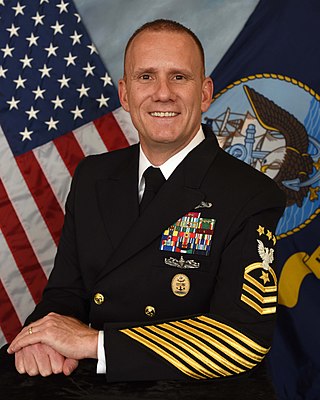
A non-commissioned officer (NCO) is a military officer who does not hold a commission. Non-commissioned officers usually earn their position of authority by promotion through the enlisted ranks. In contrast, commissioned officers usually enter directly from a military academy, officer training corps (OTC) or reserve officer training corps (ROTC), or officer candidate school (OCS) or officer training school (OTS), after receiving a post-secondary degree.
A chief petty officer (CPO) is a senior non-commissioned officer in many navies and coast guards, usually above petty officer.
Senior Chief Petty Officer(SCPO) is an enlisted rank in the navies of some countries.

Command master chief petty officer (CMDCM) is an enlisted rating in the United States Navy and U.S. Coast Guard, as well as the Japan Maritime Self-Defense Force.

The master chief petty officer of the Navy is a unique non-commissioned rank and position of office of the United States Navy, which is designated as a special paygrade above E-9. The holder of this position is the most senior enlisted member of the U.S. Navy, equivalent to the sergeant Major of the Army, chief master sergeant of the Air Force, sergeant major of the Marine Corps, master chief petty officer of the Coast Guard, and chief master sergeant of the Space Force. The holder of this rank and position is the most senior enlisted sailor in the Navy, unless an enlisted sailor is serving as the senior enlisted advisor to the chairman. The current MCPON is James Honea.
A petty officer (PO) is a non-commissioned officer in many navies. Often they may be superior to a seaman, and subordinate to more senior non-commissioned officers, such as chief petty officers.
A Petty officer third class is a non-commissioned officer in some navies and coast guards.
Petty officer second class (PO2) is a rank found in some navies and maritime organizations.
Petty officer first class (PO1) is a rank found in some navies and maritime organizations.

USS Chief (MCM-14) is an Avenger-class mine countermeasures ship of the United States Navy. She was named for the former USS Chief (AM-315), which in turn was named in honor of all chief petty officers of the US Navy.
Before Unification as the Canadian Armed Forces in 1968, the Canadian military had three distinct services: the Royal Canadian Navy, the Royal Canadian Air Force, and the Canadian Army. All three services had a Regular (full-time) component and a reserve (part-time) component. The rank structure for these services were based on the services of the British military, the Royal Navy, the Royal Air Force, and the British Army. The change to a "Canadian" rank structure meant that many of the traditional (British) rank titles and insignia were removed or changed.

In the United States Armed Forces, the ranks of warrant officer are rated as officers above all non-commissioned officers, candidates, cadets, and midshipmen, but subordinate to the lowest officer grade of O‑1. This application differs from the Commonwealth of Nations and other militaries, where warrant officers are the most senior of the other ranks, equivalent to the U.S. Armed Forces grades of E‑8 and E‑9.

Command Senior Enlisted Leader Identification Badges are special United States Navy and United States Coast Guard badges which are issued to the most senior Chief Petty Officer or higher in a given U.S. Navy or U.S. Coast Guard command. The command may either be a shore or sea unit.
Chief Petty Officer (CPO) is the seventh enlisted rank in the United States Navy and U.S. Coast Guard, is above Petty Officer First Class and below Senior Chief Petty Officer. The term "rating" is used to identify enlisted job specialties. In this way, enlisted personnel are segregated into three segments containing different enlisted ranks. Furthermore, rates are broken down into three levels: non-rated members without a designated occupation. Advancement to E-4 and above is dependent on graduating from a specialty school that define what the enlisted is rated for. Petty officers and chief petty officers are part of the rated force and considered extremely knowledgeable about their particular rating. Examples include Culinary Services Chief and Aviation Maintenance Chief. The Chief Petty Officer is the rank. Gunners Mate is a rating. E7 is a pay grade. The term rating is used to identify the career field of a chief petty officer. For example, the title of a chief petty officer in the Master-at-Arms rating would be spoken or spelled out as Chief Master-at-Arms. The title would be abbreviated MAC. The grade of chief petty officer was established on 1 April 1893 in the United States Navy. The United States Congress first authorized the Coast Guard to use the promotion to Chief Petty Officer on 18 May 1920. Chief petty officer is also the final cadet grade in the United States Naval Sea Cadet Corps.

The Master-at-Arms (MA) rating is responsible for law enforcement and force protection in the United States Navy—equivalent to the United States Army Military Police, the United States Marine Corps Military Police, the United States Air Force Security Forces, and the United States Coast Guard's Maritime Law Enforcement Specialist. It is one of the oldest ratings in the United States Navy, having been recognized since the inception of the U.S. Navy.

Steven S. Giordano is a retired United States Navy sailor who served as the 14th Master Chief Petty Officer of the Navy.

Russell L. Smith is a United States Navy sailor who served as the 15th Master Chief Petty Officer of the Navy (MCPON). He was acting MCPON from June 22, 2018, when Steven S. Giordano resigned, to August 29, 2018, when he officially assumed the role.





















